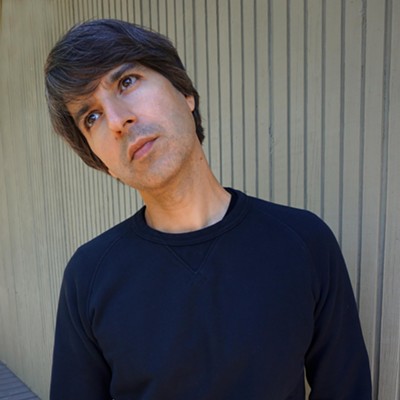"At 53, I am at that point in life where I should be slowing down," he says. "But for the first time, I listened to that little voice inside of me that kept saying, 'I am an artist,' and transformed myself."
McArdle is referring to an intense journey that opened up a new world to the former photojournalist. McArdle has expressed an interest in photography since he was given a Polaroid Swinger camera at the age of 10.
"I would take pictures of my sister and was truly fascinated by what the camera captured," McArdle says.
After joining the Marine Corps at the age of 19 in 1973, McArdle was given a list of positions to choose from; on the list was the job of official photographer.
"As a photographer for the Marine Corps, I took aerial shots hanging out of helicopters, out in fields during war games, of autopsies and accident scenes," McArdle recalls. "I traveled to Japan for 13 months, also to take photographs."
The Marine Corps owned the photographs McArdle shot, so he purchased a camera to also capture images of his own.
"I was always involved with the developing process as the years went by," McArdle says. "After my time with the Marine Corps, I moved to Hollywood, Fla., and studied music."
After a motorcycle accident that left McArdle temporarily paralyzed, he was forced to give up music.
"I was devastated. My left hand would freeze up, and with guitar work, that can't be happening," he says.
After recovering from the accident in his home state of Michigan, McArdle returned to what he knew best--photography. He packed up and moved to Flagstaff, where he studied photojournalism at Northern Arizona University. McArdle says he wrote and took photos for the Navajo Hopi Observer on the reservation in Flagstaff.
"I was primarily a writer. It was a bonus for them that I also took photos," McArdle says.
McArdle became a freelancer and worked for newspapers in Michigan and San Diego for about 25 years, where news-related stories were his main focus. After getting in touch with a former girlfriend from his days at NAU, McArdle found himself in Arizona again--this time, in Tucson.
After marrying his sweetheart, McArdle realized that something inside was urging him to try something new with his photography.
"I was really broke and working outside of my field, laying tile. I was having mini-breakdowns looking for some way to express myself," he says. "After turning 50, I had sort of a spiritual awakening."
After making the transition to digital photography and utilizing computer technology, McArdle sorted through thousands of film negatives--some of family and personal events, others of his travels and experiences as a photojournalist.
"The answer was right there: I didn't need to reinvent myself; I just had to use what I had," he says.
Thus began McArdle's artistic revolution.
"I took all of these photographs, some from 25 years ago, and began layering them," McArdle says of his artwork. "Maybe I was so drawn to them because they were of all of my personal experiences, and I inadvertently created a piece of art out of my images."
McArdle says his images, like one he created by layering a photograph he took at a Day of the Dead celebration on top of a photograph of his deceased father, allowed him to notice a transformation in his work. Having shown some of his photojournalism pieces before, he says he finally found work worthy of its own art exhibit.
Patrick McArdle's new photographic endeavor, Miracles and Transformation, depicts his journey through years of photojournalism and the transition from film to digital photography. The opening reception will be held from 7 to 10 p.m., Saturday, Aug. 18, at McArdle's Freedomheart Gallery, 657 W. St. Mary's Road. No. 11. Following the reception, the exhibit will be open by appointment only. For more information, call 661-5197.







